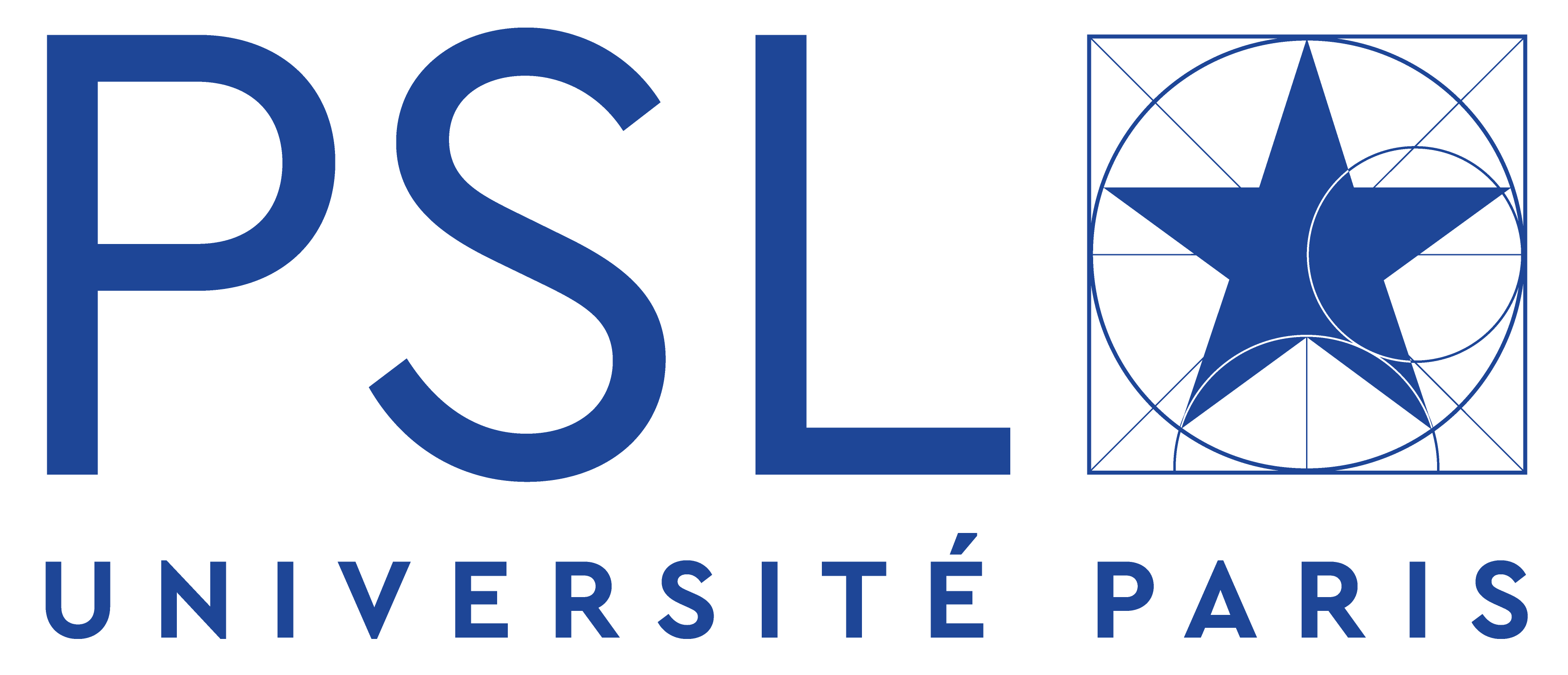Acousto-rhéologie des milieux granulaires
Les milieux granulaires consistent en des assemblées de particules solides macroscopiques qui interagissent via des forces de contact dissipatives. L’intérêt suscité par ces milieux dans différentes communautés (physique, géophysique et génie civil) s’explique non seulement par le fait qu’ils jouent un rôle important dans de nombreux domaines de l’industrie ou en géophysique mais aussi parce qu’ils constituent un système modèle des matériaux amorphes et athermiques, hors d’équilibre et métastables.
Notre recherche se concentre à la transition de l’état solide vers l’état liquide de ces systèmes modèles où nous utilisons des ondes élastiques, de compression et de cisaillement, à la fois comme une sonde des granulaires (secs, mouillés ou immergés) mais aussi comme une pompe pour induire cette transition de déblocage. Nous explorons ainsi les réponses acoustiques non linéaires du matériau telles que le ramollissement des vitesses d’ondes et la décorrélation des ondes multiplement diffusées (en analogie avec les expériences DWS en optique) lié aux glissements de grains ou/et réarrangements des réseaux de contacts. Ces recherches permettent de mieux comprendre les phénomènes catastrophiques tels que les glissements de terrain et tremblements de terre déclenchés par la sismicité.
Retournement temporel dans les milieux granulaires
Dans ce contexte, nous avons en particulier réalisé la première expérience de retournement temporel dans un matériau granulaire [Harazi et al, 2017]. Lorsqu’un tel milieu est insonifié par une impulsion brève, le signal transmis consiste en un signal direct, l’onde balistique, suivi d’une onde multiplement diffusée, l’onde de Coda. Nous avons notamment montré que la focalisation des ondes balistiques sur la position de la source s’avère robuste, quelle que soit l’amplitude d’excitation, mais offre une résolution spatiale moins bonne qu’avec la Coda. On retrouve là un résultat qui avait été mis en évidence dans d’autres types de milieux multiplement diffuseurs. Cependant, lorsque l’amplitude de l’onde émise dans le milieu augmente, l’efficacité de la focalisation obtenue par retournement temporel de la Coda diminue à cause du réarrangement des réseaux de contact induit lors de la propagation aller. Ainsi, la méthode de focalisation par RT apparaît comme un bon moyen d’étudier l’interaction non linéaire irréversible onde-matière dans les matériaux granulaires. Nous cherchons actuellement à utiliser ce procédé de focalisation pour déclencher à distance des réarrangements locaux de façon contrôlée.
– Harazi, M., Y. Yang, M. Fink, A. Tourin, and X. Jia “Time reversal of ultrasound in granular media,” European Physical Journal : Special Topics 226, no. 7, 1487-1497 (2017)

Fig. 1. Expérience de retournement temporel à travers un milieu granulaire : a) Empilements des billes de verre millimétriques, placé entre un traducteur source et un réseau de 16 transducteurs piézoélectriques de contact jouant le rôle de Miroir à Retournement Temporel ; b) Signal typique de la transmission ultrasonore ; c) L’onde de Coda corresponds à la diffusion multiple des ondes par les chaînes de forces ; d) La source initiale est entourée de transducteurs qui, dans la phase retour, permettent de mesurer la finesse de résolution spatiale ; e) Au milieu : signaux mesurés à la position de la source initiale (S1) et sur deux récepteurs voisins (S2 et S3) après retournement temporel de l’onde de Coda ; f) L’illustration du RT monovoie avec l’onde de Coda.
Caractérisation d’endommagement des matériaux poreux granulaires par ondes ultrasonores
La détermination de la diffusion et de l’absorption des ultrasons dans des milieux hétérogènes et/ou fracturés est d’une importance primordiale, de la caractérisation des matériaux aux applications géophysiques. Pour ce faire, nous avons réalisé des mesures ultrasonores combinées (actives et passives) avec des essais mécaniques lors de la nucléation de la fracture et des simulations numériques pour résoudre des problèmes inverses.
En collaboration avec China University of Petroleum à Qingdao, nous avons étudié la diffusion multiple des ultrasons dans les roches (granite et schiste). Par des simulations de Monte-Carlo, nous confirmons l’applicabilité de l’équation de transfert radiatif ou de l’approximation de diffusion, dépendant de l’épaisseur de l’échantillon (slab) [Zhou et al, 2021]. Cela nous a permis de déduire séparément les atténuations de diffusion et intrinsèques dans ces matériaux hétérogènes ou fracturés et de montrer l’augmentation d’une longueur caractéristique d’un schiste intact à un schiste fracturé [Zhou et al, 2023].
En collaboration avec l’ISTERRE de Grenoble, nous avons également étudié la nucléation de l’endommagement dans les roches synthétiques (matériaux granulaires cimentés) de l’état cohésif à l’état non-cohésif sous un chargement axial. Lors d’une compaction inélastique, des chutes de contraintes de type stick-slip ont été observées dans des granulaires cimenté avec de joints fragiles. Elles sont accompagnées d’une diminution instantanée de la vitesse des ondes P et des émissions acoustiques (i.e., tremblements dans le laboratoire), qui semble être contrôlés par le processus local de rupture des liaisons entre les grains confirmé par des simulations FE [Canel et al, 2023].
– Zhou, H., X. Jia, L. Y. Fu, and A. Tourin, "Monte Carlo Simulations of Ultrasound Scattering and Absorption in Finite-Size Heterogeneous Materials," Phys. Rev. Applied 16, 034009 (2021)
– Zhou, H., X. Jia, L. Y. Fu, and A. Tourin, "Seismic Wave Scattering and Dissipation in Fractured Shales," arXiv:2301.00713 (2023)
– Canel,V., M. Campillo, X. Jia, and I. Ionescu, "Damage in cohesive granular materials : simulations and geophysical implications," Comptes Rendus - Geoscience 355, no. S3, 1-21 (2023)

Fig. 2. Roches schistes. (a1) L’échantillon initial intact (photo) avec des micro-fissures inhérentes (a2, image MEB). (b1) L’échantillon final fracturé après chauffage-refroidissement cycliques (image aux rayons X) avec des macro-fissures induites thermiquement (b2, image MEB). (c) Ondes diffusées typiques obtenues avec une source d’ondes de cisaillement et un petit détecteur. S représente l’onde balistique transversale et les traces de signal "1-3" indiquent la séquence des expériences avec la roche initial intacte (1), les roches fracturées moyennement (2) et fortement (3). Les libres parcours moyens de transport l* sont déduits par simulations éléments finis de la diffusion des ondes SH basées sur la tomographie à rayons X de la roche schiste fracturée [Zhou et al, 2023].
Déclenchement par vibrations acoustiques des instabilités granulaires
Un lit granulaire commence à s’écouler au-delà d’un angle d’avalanche et se stabilise à nouveau à un angle de repos (Fig. 3A). Cependant, cette couche granulaire peut être déstabilisée en dessous de l’angle d’avalanche, s’elle est soumise à une perturbation extérieure. C’est ainsi que certains glissements de terrain ou éboulement de rochers ont lieu par des vibrations dues à une activité sismique locale (Fig. 3B) ou à des séismes lointains, un phénomène encore mal compris [Durand et al, 2018)]. En collaboration avec l’IPGP, nous avons apporté un nouveau éclairage sur cette problématique par des expériences du laboratoire en utilisant des ultrasons d’amplitude nanométrique (déformation < 10-5) pour déclencher des avalanches granulaires [Léopoldès et al, 2020]. Des écoulements de type fluage et continu ont été observés en fonction de l’angle d’inclinaison. Ici l’amplitude de vibration étant trop faible pour induire un réarrangement macroscopique des grains, une telle fluidisation acoustique est donc reliée à la lubrification ultrasonore des contacts entre grains (température effective), induisant une diminution de frottement interparticule.
Nous avons également étudié l’instabilité induite par les vibrations dans le contexte des sables mouvants où la liquéfaction des sols (granulaires) due aux vibrations sismiques peut entraîner des catastrophes telles que l’effondrement de bâtiments, de barrages ou de ponts. En plus de l’effet bien connu de l’augmentation de la pression interstitielle résultant de la compaction des sols induit par vibration, nous avons découvert un nouveau mécanisme dans lequel la transition des granulaires d’un état solide à un état fluide résulte d’une lubrification acoustique des contacts entre grains. Ce scénario a été confirmé par le suivi de la chute d’une bille d’acier par un transducteur ultrasonore, dans une suspension granulaire opaque dense sous vibration horizontale (Fig. 4A). L’analyse à l’aide d’un modèle rhéologie frictionnelle a confirmé la diminution du coefficient de frottement et de la viscosité induite par vibration sans réarrangement visible des grains [Wildenberg et al, 2019].
Pour mieux comprendre l’instabilité granulaire induite par les ultrasons/vibrations, nous avons aussi étudié l’adoucissement de la vitesse des ondes de cisaillement dans des suspensions granulaires denses avec l’augmentation de l’amplitude de vibration, à l’aide de la technique élastographie développée à l’Institut Langevin pour l’imagerie médicale. Une diminution du module de cisaillement jusqu’à 85% a été observée lorsque la transition de déblocage s’est produite (Fig. 4B), accompagnée du réarrangement macroscopique des grains [Brum et al, 2019]. Une telle fluidisation acoustique peut également être responsable de l’instabilité stick-slip déclenchée par les vibrations que nous étudions dans les matériaux granulaires sous contrainte, en collaboration avec Chengdu University of Technology & Shanghai Jiao-Tong University, Chine [Hu et al, 2022 ; Gou et al, 2023].
– Durand, V. et al, "On the Link Between External Forcings and Slope Instabilities in the Piton de la Fournaise Summit Crater, Reunion Island," J. Geophys. Res. Earth Surface 123, 2422-2442 (2018)
– Léopoldès, J., X. Jia, A. Tourin, and A. Mangeney, "Triggering granular avalanches with ultrasound," Phys. Rev. E 102, 042901(2020)
– Van den Wildenberg, S., X. Jia, J. Léopoldès, A. Tourin, "Ultrasonic tracking of a sinking ball in a vibrated dense granular suspension," Scientific Report 9, 5460 (2019)
– Brum, J., J. -L. Gennisson, M. Fink, A. Tourin, X. Jia, "Drastic slowdown of the Rayleigh-like wave in unjammed granular suspensions," Phys. Rev. E 99, 042902 (2019)
– Hu, W. et al, "Effect of Amplitude and Duration of Cyclic Loading on Frictional Sliding Instability in Granular Media : Implication to Earthquake Triggering of Landslides," J. Geophys. Res. : Solid Earth 127, B024488 (2022)
– Gou, H.X. et al, "Stick-Slip Nucleation and Failure in Uniform Glass Beads Detected by Acoustic Emissions in Ring-Shear Experiments : Implications for Identifying the Acoustic Emissions of Earthquake Foreshocks," J. Geophys. Res. : Solid Earth 128 (2023)

Fig. 3. (A) Des billes de verre ( 100 μm en diamètre) sont déposées sur un plan rugueux. Une caméra permet de filmer l’écoulement déclenché par la vibration ultrasonore [Léopoldès et al 2020] (B) Cratère Dolomieu au Piton de la Fournaise. Plusieurs éboulements s’y produisent chaque jour. Leur occurrence et leur importance semblent liées à la sismicité locale [Durand et al, 2018].

Fig. 4. (A) Une bille d’acier s’enfonce dans une suspension de billes de verre saturée d’eau, sous vibration horizontale. La chute est suivie à distance par un sonar à ultrasons (photo prise par Alister Trabattoni). (B) (a) Schéma du montage expérimental : l’onde de Rayleigh est excitée par une plaque rugueuse dans un sédiment dense de billes de verre. (b) Le déplacement des particules hors du plan est déduits de la corrélation des ultrasons rétrodiffusés avec un scanner à ultrasons ultrarapide [Brum et al, 2019].
Diffusion des ondes ultrasonores et imagerie dans des suspensions granulaires denses
La propagation acoustique dans des suspensions composées de particules solides et d’un fluide visqueux est un problème important aussi pour l’application géophysique et la caractérisation de matériaux non intrusifs. En collaboration avec l’Universidad de la Republica à Montevideo, Uruguay (thèse en cotutelle de Y. Abraham), nous avons mesuré les paramètres de transport des ultrasons dans des suspensions denses de billes de verre. A partir de la rétrodiffusion cohérente où le libre parcours moyen et le coefficient de diffusion ont été mesurés simultanément, nous avons déduit une vitesse d’énergie bien inférieure à la vitesse du son dans l’eau, ce qui suggère une forte diffusion résonnante. Nous avons calculé les vitesses de phase et de groupe des ondes cohérentes dans ce milieu à l’aide de Coherent Potential Approximation généralisée. Ces calcules ont bien montré une importante diminution des vitesses de groupe et de l’énergie autour des fréquences de résonance.
Imager un intrus à l’intérieur d’un milieu fortement diffusant, comme une suspension granulaire dense, est non seulement un défi pratique mais aussi un problème fondamental qui peut être abordé selon une approche matricielle (thèse d’A. Le Ber encadrée par A. Aubry). En parallèle, nous avons développé une méthode rhéoacoustique pour localiser un intrus enfoui dans une suspension granulaire dense. En utilisant une sonde ultrasonore mono-élément, un écho ultrasonore cohérent est extrait d’une bille d’acier immergée grâce à un processus de moyenne de configurations différentes obtenues par le mouvement non affine des billes cisaillées (Fig. 5) [Wildenberg et al, 2022].
Enfin, en collaboration avec F. Ramaz, nous effectuons une détection acousto-optique dans ces suspensions granulaires où la lumière et les ultrasons se propagent tous deux dans le régime de diffusion multiple conduisant à un résultat original : le profil acousto-optique porte à long terme une information sur la diffusion multiple des ultrasons à l’intérieur de la tache de diffusion de la lumière. Un modèle théorique est en cours de développement par R. Pierrat dans le but d’extraire les paramètres de transport ultrasonore de ce profil.
– S. van den Wildenberg, X. Jia, J.-L. Gennisson, and A. Tourin, "Acoustic Localization of an Intruder in a Strongly Scattering Medium," Phys. Rev. Applied 18, 064097 (2022)

Fig. 5. (a) Dessin du dispositif expérimental. Une bille d’acier de diamètre D = 30 mm est immergée dans une suspension dense de billes de verre (d ∼ 600 μm) à une profondeur Z ∼ 30l* (l* d est le libre parcours moyen de transport). Un transducteur ultrasonore (A) est utilisé pour envoyer une courte impulsion et mesurer l’écho de la bille. Différentes configurations de diffusion sont générées par une pale de mélange L = 5 cm à vitesse de rotation Ω = 23 rpm placée à une distance χ = 8 cm. (b) Des traces acoustiques sont ensuite obtenues pour un nombre croissant de signaux moyennés. L’écho cohérent de l’intrus devient visible après quelques dizaines de secondes de mesure, ce qui est encore plus évident dans les spectrogrammes [Wildenberg et al, 2023].
Contacts :
- Xiaoping Jia
- Arnaud Tourin









